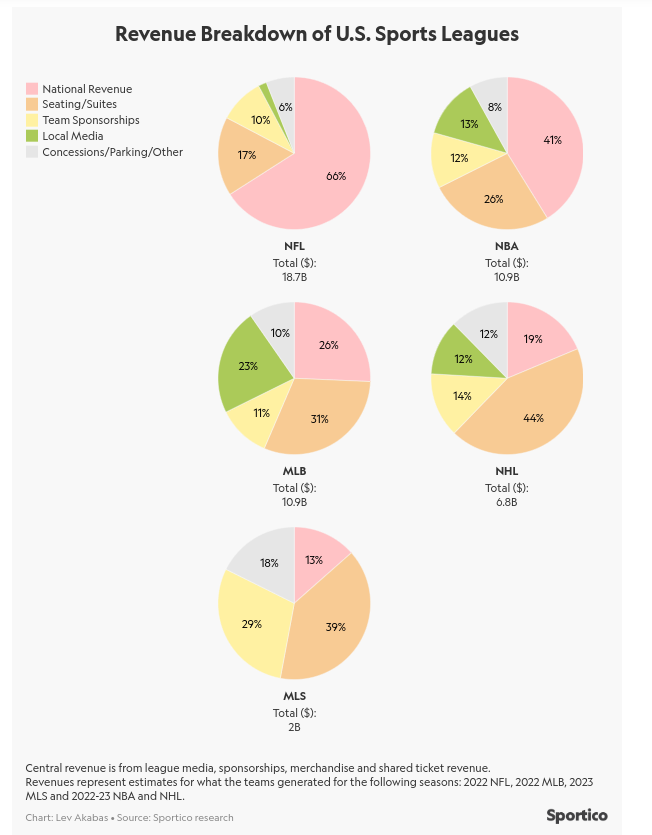The National Hockey League reached new heights in 2023-24, setting record highs for league revenues and attendance. But they’re still well behind the other three major North American sports leagues: the NFL, MLB, and the NBA. How the different leagues bring in money can reveal why that’s the case.
Here is a breakdown of how the NHL brings in money compared to other leagues, where they excel, and where they still have a ways to go.
Reliance on Ticket Sales and Game Day Purchases
Following this year’s Super Bowl, Sportico released its breakdown of the leagues’ different revenue sources. While the NHL wasn’t the only league to have a major portion of the revenue come from ticket sales, it stood out how significant it was compared to other leagues.

A whopping 44% of the NHL’s revenues come from ticket sales. The difference in how much each league brings in at the gates isn’t that much different except for the MLS (Major League Soccer).
Ticket revenues by league in order of revenue:
- MLB: $3.3 billion
- NFL: $3.1 billion
- NHL: $3 billion
- NBA: $2.9 billion
- MLS: $800 million
However, the NHL is the only league where ticket sales are over 40% of revenue. Even the much smaller MLS’s ticket sales accounted for 39% of revenue. NHL teams also keep a much higher share of ticket revenues compared to other sports leagues.

NHL teams also pocket 65% of postseason revenue, which is significantly higher than the other leagues. Based on the other streams of revenue, they need a high percentage in order to make money.
Related: ESPN’s NHL Coverage Is Far From What Was Promised
The NHL also has the second-highest share of revenue that comes from other gameday-related spending, such as parking passes and concessions (12%). Combine that with ticket sales and 56% of the league’s revenue is reliant on people coming out to the arena for a game.
A Massive Lack of National Revenue
Ok, before we go further, what exactly is national revenue? Also referred to as central revenue or shared revenue by Sportico, national revenue is any revenue that comes in via deals made with the league as opposed to the teams themselves.
The NFL is all about the national money with two-thirds of its revenue coming from that stream. They also are far ahead of everyone else in this category, bringing in over $12 billion in national revenue. This national revenue is greater than the revenue of the other leagues individually. The NBA has also started to rake in nationwide money with almost $5 billion in revenue – 41% of the league’s entire revenue.
Meanwhile, the NHL’s national revenue has yet to even reach $1.5 billion.
Along with MLB and MLS, they’re still relying much more on local revenue streams such as local TV deals and team sponsorships. Only radio and preseason games are local for the NFL.
With the debacle surrounding the fate of the RSN (regional sports network), it’s unlikely the NHL is going to see much improvement in that area. They had to cut a deal with Diamond Sports Group to ensure broadcasts would go unaffected through the 2023-24 season (NHL, Diamond Sports Group reach agreement to continue local broadcasts through 2023-24, The Athletic, Dec. 20, 2023).
The NHL is setting itself up for more league-wide revenue streams. For example, they signed a deal to stream Monday night games on Amazon Prime in Canada earlier a few months back.
Conclusion
The NHL is making record-high revenues and for good reason. Hockey has grown significantly in popularity in the United States and nearly all teams are showing healthy draws to games as a result.
They make money, but nowhere near the money of their counterparts in other sports. As long as more than half the money generated by the league comes from fans at the arena, they’re going to trail the other leagues.
For those wondering why the NHL stars can make so little compared to athletes in other sports, here’s your answer. But the growth of the sport in recent years could eventually lead to more generated from other sources. As long as the league doesn’t hold itself back, which it is certainly guilty of doing in the past, then the bigger money will come in due time.
